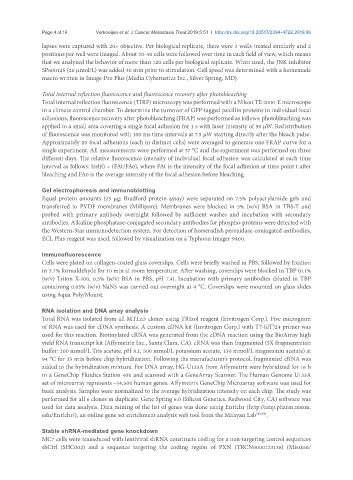Page 375 - Read Online
P. 375
Page 4 of 16 Verkoeijen et al. J Cancer Metastasis Treat 2019;5:51 I http://dx.doi.org/10.20517/2394-4722.2019.06
lapses were captured with 20× objective. Per biological replicate, there were 3 wells treated similarly and 2
positions per well were imaged. About 30-40 cells were followed over time in each field of view, which means
that we analyzed the behavior of more than 120 cells per biological replicate. When used, the JNK inhibitor
SP600125 (20 mmol/L) was added 30 min prior to stimulation. Cell speed was determined with a homemade
macro written in Image-Pro Plus (Media Cybernetics Inc., Silver Spring, MD).
Total internal reflection fluorescence and fluorescence recovery after photobleaching
Total internal reflection fluorescence (TIRF) microscopy was performed with a Nikon TE 2000-E microscope
in a climate control chamber. To determine the turnover of GFP-tagged paxillin proteins in individual focal
adhesions, fluorescence recovery after photobleaching (FRAP) was performed as follows: photobleaching was
applied to a small area covering a single focal adhesion for 1 s with laser intensity of 50 mW. Redistribution
of fluorescence was monitored with 100 ms time intervals at 7.5 mW starting directly after the bleach pulse.
Approximately 20 focal adhesions (each in distinct cells) were averaged to generate one FRAP curve for a
single experiment. All measurements were performed at 37 °C and the experiment was performed on three
different days. The relative fluorescence intensity of individual focal adhesion was calculated at each time
interval as follows: Irel(t) = (FAt/FA0), where FAt is the intensity of the focal adhesion at time point t after
bleaching and FA0 is the average intensity of the focal adhesion before bleaching.
Gel electrophoresis and immunoblotting
Equal protein amounts (25 mg; Bradford protein assay) were separated on 7.5% polyacrylamide gels and
transferred to PVDF membranes (Millipore). Membranes were blocked in 5% (w/v) BSA in TBS-T and
probed with primary antibody overnight followed by sufficient washes and incubation with secondary
antibodies. Alkaline phosphatase-conjugated secondary antibodies for phospho-proteins were detected with
the Western-Star immunodetection system. For detection of horseradish peroxidase-conjugated antibodies,
ECL Plus reagent was used, followed by visualization on a Typhoon Imager 9400.
Immunofluorescence
Cells were plated on collagen-coated glass coverslips. Cells were briefly washed in PBS, followed by fixation
in 3.7% formaldehyde for 10 min at room temperature. After washing, coverslips were blocked in TBP (0.1%
(w/v) Triton X-100, 0.5% (w/v) BSA in PBS, pH 7.4). Incubation with primary antibodies diluted in TBP
containing 0.05% (w/v) NaN3 was carried out overnight at 4 °C. Coverslips were mounted on glass slides
using Aqua Poly/Mount.
RNA isolation and DNA array analysis
Total RNA was isolated from all MTLn3 clones using TRIzol reagent (Invitrogen Corp.). Five microgram
of RNA was used for cDNA synthesis. A custom cDNA kit (Invitrogen Corp.) with T7-(dT)24 primer was
used for this reaction. Biotinylated cRNA was generated from the cDNA reaction using the BioArray high
yield RNA transcript kit (Affymetrix Inc., Santa Clara, CA). cRNA was then fragmented (5X fragmentation
buffer: 200 mmol/L Tris acetate, pH 8.1, 500 mmol/L potassium acetate, 150 mmol/L magnesium acetate) at
94 °C for 35 min before chip hybridization. Following the manufacturer's protocol, fragmented cRNA was
added to the hybridization mixture. For DNA array, HG-U133A from Affymetrix were hybridized for 16 h
in a GeneChip Fluidics Station 400 and scanned with a GeneArray Scanner. The Human Genome U133A
set of microarray represents ~14,500 human genes. Affymetrix GeneChip Microarray software was used for
basic analysis. Samples were normalized to the average hybridization intensity on each chip. The study was
performed for all 6 clones in duplicate. Gene Spring 6.0 (Silicon Genetics, Redwood City, CA) software was
used for data analysis. Data mining of the list of genes was done using Enrichr (http://amp.pharm.mssm.
edu/Enrichr/), an online gene set enrichment analysis web tool from the Ma'ayan Lab [45,46] .
Stable shRNA-mediated gene knockdown
MC7 cells were transduced with lentiviral shRNA constructs coding for a non-targeting control sequences
shCtrl (SHC002) and a sequence targeting the coding region of PXN (TRCN0000123138) (Mission/

